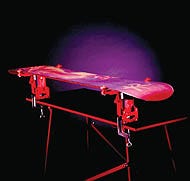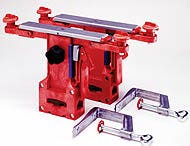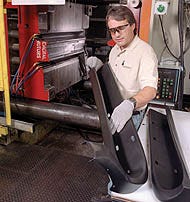November 1, 2001
Nanocomposites: Auto exteriors and beyond
|
Steve Hubbard, process technician at Blackhawk Automotive Plastics, examines an injection molded nanocomposite step-assist before it is painted and assembled at Blackhawk's molding facility in Mason, OH. |
Nanocomposite TPOs are no longer the exclusive domain of researchers, according to a recent announcement by General Motors. "It's not often that we get to introduce a new structural material," says Alan Taub, executive director of science for GM Research & Development. "We are now in production with a van step-assist that is molded from a new TPO nanocomposite material and found on the 2002 GMC Safari and Chevy Astro vans. It represents the first automotive application for this material."
Three years ago, GM and Basell Polyolefins (then named Montell) announced that work had begun on a new nanocomposite TPO material with a smectite clay filler. The new TPO was developed at the GM R&D Center in Warren, MI together with its suppliers Basell and Southern Clay Products under a mutual confidentiality agreement. "We decided to proceed with this as a partnership rather than a patent," says Taub, "because we believe that partnering is the fastest way to bring innovative technology to market."
The nanocomposite step-assist replaces a talc-filled TPO version and saves up to 20 percent in weight. According to Taub, other benefits include a Class A exterior surface, better processibility, greater ductility at lower temperatures, and stiffness equivalent to that of talc-filled TPO. The step-assist is the first of several planned applications and GM confirms that it is studying interior applications as well.
Blackhawk Automotive Plastics molds and paints the parts for GM and was also involved in development work. Mark Bennett, advanced programs manager for Blackhawk, explains that the new TPO is molded in the same tools as the former talc-filled material but at faster cycles and with better part quality. "We can run the nanocomposite material at slightly lower temperatures," he says, "and can fill the tool more quickly because there is less filler in the resin."
WHY GO NANO? As they make the move from research to production, nanocomposite TPO materials may become attractive to designers in various markets. What they offer is a blend of weight reduction, greater stiffness, and increased ductility at low temperatures. By volume, nano parts cost about the same as conventional TPO parts because less material is needed to make them. Nano TPOs can also be molded in tools made for conventional TPOs. The filler material for most nanocomposites, smectite clay, is a family of high-purity clay materials. Combining the clay particles with a polymer is the real trick to developing a successful material. For the step-assist material, GM came up with a method of developing the nano-sized layers of clay, while Basell worked on a process for distributing the microscopic particles into the TPO matrix. |
In fact, a TPO material with 2.5 percent nano filler is as stiff as parts with 10 times the amount of talc filler. The nano filler is so named because it consists of tiny flakes of clay that are only one nanometer (or one-millionth of a millimeter, 10-9m) thick. Conventional fillers, by comparison, are one thousand times thicker. Says Taub, "These clay particles have huge surface areas. For example, five grams of this material would cover a football field."
Nanocomposite materials are making headway in other applications as well, according to compounder RTP, which introduced a nanocomposite nylon 6 material (filled with nano-sized clay particles) more than two years ago. "A major advantage of nanocomposite nylon 6 is the increase in heat deflection temperatures over the unfilled resin, comparable to a 20 to 30 percent load in a standard mineral-filled compound," says Sam Dahman, product development engineer for RTP. "Particularly for underhood automotive applications, engineers can maintain the HDT [heat deflection temperature] while reducing the weight of the component."
Most of RTP's nanocomposite nylon is being purchased for film packaging applications at this point, according to Dahman. However, RTP is in a precommercial stage of development for olefinic nanocomposites aimed at the automotive industry. "We are starting to sample nano grades of PP and other olefins," he adds.—Michelle Maniscalco
Contact information |
 Glow-in-the-dark compounds enhance emergency trunk release
Glow-in-the-dark compounds enhance emergency trunk release
Next time you find yourself locked in the trunk of a car, take a moment to search for this handy release. It's made by Delphi Automotive Systems and is molded with an LNP Engineering Plastics glow-in-the-dark (GID) compound called Colorcomp Glow that activates quickly. The handles are molded of a polypropylene base resin with phosphorescent pigments that reportedly activate much faster than traditional GID resins. This was a determining factor in emergency trunk handles because a trunk door is usually open for only brief periods of time. Additional benefits of Colorcomp Glow in this application include easy molding and good toughness.
This GID resin is a high-intensity compound that reportedly glows up to 10 times longer and brighter than standard phosphorescent compounds. It can be combined with almost any base resin, although the most intense glow is obtained in combination with polypropylene, ABS, and amorphous nylon.
End use opportunities are broad, with applications revolving around safety and improved visibility. These include construction cones and helmets; sports and recreational products such as boat safety gear, dive gauges, and watches; and miscellaneous switches, levers, dials, and other indicators. The high-intensity GID resins cost around $100 to $150/lb and can be combined at varying ratios with pigments, which run around $15 to $20/lb, and polypropylene, which costs less than $1/lb.
Contact information |
Online partnership
A partnership has been formed between 3Ga Corp. and MatWeb.com, a free, online materials database. This collaboration is said to allow 3G.web.decisions' customers to accelerate material specifications and cost analysis processes since 3G.web.decisions links directly to MatWeb.com's online materials database and imports information on any materials listed. Therefore, MatWeb's online database can be accessed in real time from 3Ga applications via the Internet to help ensure material property accuracy. An agreement was negotiated between the two companies for 3Ga Corp. to be the premier reseller of the new premium service. 3Ga will also be the first to offer MatWeb's premium database as part of a corporate intranet database alternative for organizations. Some of the features of the premium database include advanced search features, side-by-side material comparisons, and a new export feature enabling the user to download selected data sheets into a spreadsheet or text file. The premium database is not currently available, but is anticipated to be up and running within the next month.
Contact information |
 Durability, dampening properties sought for snowboard vise
Durability, dampening properties sought for snowboard vise
Looking to improve the strength, grip, and rigidity of its snowboard vise, Swix Sport teamed with designer Innovation Inc. and manufacturer Advanced Polymer Alloys for a redesign. It was imperative that the vise, which is used to secure an inverted snowboard to a workbench in order to keep it stable during tuning, maintain a tight grip without marring the board and absorb the energy associated with the waxing and sharpening performed on a board.
Flaws in the previous design stemmed from the use of rubber extrusions adhered to a polycarbonate skeleton, which caused the vise to impart poor friction and inadequate dampening properties. The goal with the redesign was to eliminate these flaws and improve processing. The companies sought a material that would adhere directly to the support in order to eliminate the time and costs of the middle adhesion step.

The first change was the replacement of the toggle clamps with new twist-lock mechanisms. Now, any board, regardless of width or thickness, can be fastened to the T-supports. Using Alcryn melt-processible rubber (MPR), a durable, high-friction, energy-absorbing bumper was molded directly onto the existing polycarbonate T-supports using coinjection. This process also eliminated the labeling stage of the process by enabling Swix Sport to mold a logo directly onto the bumper. The final product is said to be nonmarking, easy to clean, and durable.
Contact information |
You May Also Like



